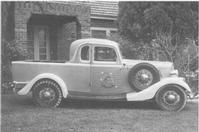


Chapter 7
I The First 100 Years 1788-1888
II Railways
III Motorised Vehicles
i Trucks
ii Truck Manufacturing
iii Road Trains
iv The Diesel Electric Ore Trucks
v Buses and Coaches
IV Aviation
V Modern Shipping
VI Innovative Small Craft
VII Conclusion
VIII Acknowledgements
IX Contributors
References
Index
Search
Help
Contact us

The Australian farming community, although skeptical at first, gradually came to see the useful application of the motor car and began to adapt vehicles to perform the many and varied carrying tasks of the farms. It is not surprising that graziers would convert their older passenger cars which had seen long service, to carry loads on a buckboard which extended behind the front seat. This conversion required some structural strengthening and modifications, but created a very utilitarian runabout, able to carry sacks or sheep or supplies from the local store. This useful work-horse around the farms was a simple application of ingenuity by practical people and when the need for such a vehicle was brought to the attention of Ford Motor Company of Australia in 1930 they initiated plans to design and manufacture such a vehicle. The design was completed by Lewis Bandt at Geelong and in 1934 the first production Ford coupe utility was assembled, a unique Australian vehicle to meet what was thought to be peculiar Australian needs.
The first coupe utility (Fig. 18) followed the general design of the farmers' passenger car conversions, but introduced a styling theme and engineering improvements, which gave the vehicle some claim to use both as a respectable transport for people and goods. In latter years the coupe utility has become an established model in Australian vehicle manufacturers' ranges and with its modern refinements of power accessories etc., it is hard to recognise its humble beginnings. In a curious reverse of the normal flow of importing vehicle designs from overseas, both the U.S. multinationals of General Motors and Ford produced coupe utilities based on Australian experience in North America as distinct from the regular pickup trucks, and similar vehicles are now also manufactured in South Africa.

A number of Australian firms became involved in the servicing and parts replacement business. In 1919 Chamberlain established the Australian Ball Bearing Company which became involved with the reconditioning of ball bearing races and developed a technique of manufacturing inner and outer cages using imported ball bearings.[17]
Repco, a major automobile supplier of both original equipment and replacement parts sales developed a number of technologically significant processes, including; bonding of aluminium-tin bearings, a unique brake bleeding pump, specialised ring gear rolling methods and cold extrusion techniques. Repco will also be remembered for its part in developing the Repco Brabham racing engine in the 1960s, which Sir Jack Brabham used with such success in international racing.
Motor car radiator cores were developed and manufactured in 1924 by Motor Radiators Pty. Ltd., and serviced the industry.
Die Casters Pty. Ltd., established in 1926 at Richmond, produced excellent quality castings for vehicles, such as door handles, door locks etc., and also supplied the industry with window winding mechanisms, windscreen wipers and blades. This firm developed and patented processes to enable moulding of plastic to metal which was an important breakthrough in the application of metal to plastic technology. During the Second World War Die Casters Pty. Ltd., manufactured defence type products including components of bomb sights, machine guns and engine parts for aircraft.
Organisations in Australian Science at Work - Australian Ball Bearing Company; Die Casters Pty Ltd; Ford Motor Company of Australia; Motor Radiators Pty Ltd; Repco Corporation Ltd
People in Bright Sparcs - Bandt, Lewis; Brabham, Sir Jack
 |
Australian Academy of Technological Sciences and Engineering |  |
© 1988 Print Edition pages 490 - 491, Online Edition 2000
Published by Australian Science and Technology Heritage Centre, using the Web Academic Resource Publisher
http://www.austehc.unimelb.edu.au/tia/483.html